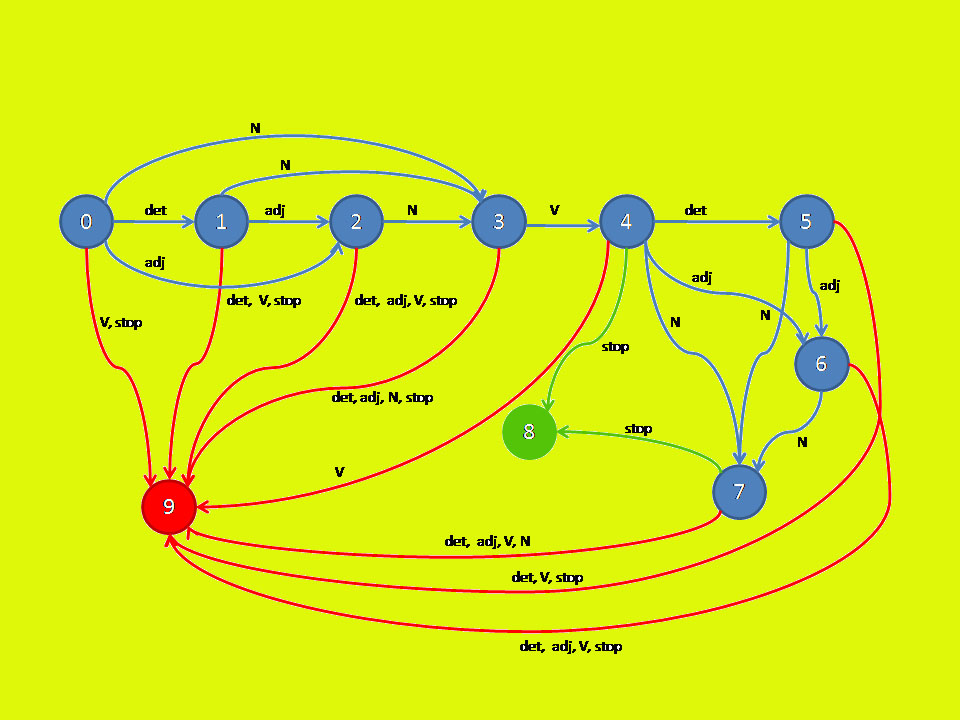Team:Sweden/Project
From 2009.igem.org
(→Project) |
(→Project) |
||
| Line 36: | Line 36: | ||
---- | ---- | ||
| - | <font color="blue">We want to implement this automaton in the cell. It is based on a few simple rules on how to parse a simple sentence like The little girl plays ball or Boys stroke the little dog. These simple rules are : | + | <font color="blue">We want to implement this automaton in the cell. It is based on a few simple rules on how to parse a simple sentence like<br>The little girl plays ball or Boys stroke the little dog.<br>These simple rules are : |
| + | <ul type="disc"> | ||
| + | <li>S NP VP | ||
| + | <li>NP (det adj) N | ||
| + | <li>VP V (NP) | ||
| + | </ul> | ||
| + | We target only the parts of speech (POS) tags which in these above grammars are:<br> | ||
| + | <ul type="disc"> | ||
| + | <li> NP:Noun Phrase VP: Verb Phrase | ||
| + | <li>(det:Determinant adj:adjective) N: Noun | ||
| + | <li>VP:Verb Phrase V:Verb NP:Noun Phrase | ||
| + | </ul> | ||
| + | This way the grammar can be implemented as a finite state automaton (FSA) and not as a push-down automaton. | ||
| - | + | A finite state automation is a 5-tupel A = (Q, Σ, δ, s0, F), where Q is a finite set of states, Σ is the finite set of input symbols (alphabet), δ is the transition function, δ: Q × Σ -> Q, s0 is the start state and F is the set of final/accepting states.</font> | |
| - | + | ||
| - | + | ||
| - | + | ==<font color="blue">Our Aim</font>== | |
| - | + | <font color="blue">The sentence in our project is a string of different reagents which will be introduced to the cell one by one. As soon as a wrong input is detected the cell will light up red. A sentence is finished by a stop reagent and then the cell will light up green. </font> | |
| - | The sentence is a string of different reagents which will be introduced to the cell one by one. As soon as a wrong input is detected the cell will light up red. A sentence is finished by a stop reagent and then the cell will light up green. </font> | + | |
---- | ---- | ||
Revision as of 12:12, 18 October 2009
| Home | Team | Project | Mathematical Modelling | Logbook | Result | Parts | Sponsors |
|---|
Project
|
We want to implement this automaton in the cell. It is based on a few simple rules on how to parse a simple sentence like
We target only the parts of speech (POS) tags which in these above grammars are:
This way the grammar can be implemented as a finite state automaton (FSA) and not as a push-down automaton. A finite state automation is a 5-tupel A = (Q, Σ, δ, s0, F), where Q is a finite set of states, Σ is the finite set of input symbols (alphabet), δ is the transition function, δ: Q × Σ -> Q, s0 is the start state and F is the set of final/accepting states. Our AimThe sentence in our project is a string of different reagents which will be introduced to the cell one by one. As soon as a wrong input is detected the cell will light up red. A sentence is finished by a stop reagent and then the cell will light up green.
|
 "
"

